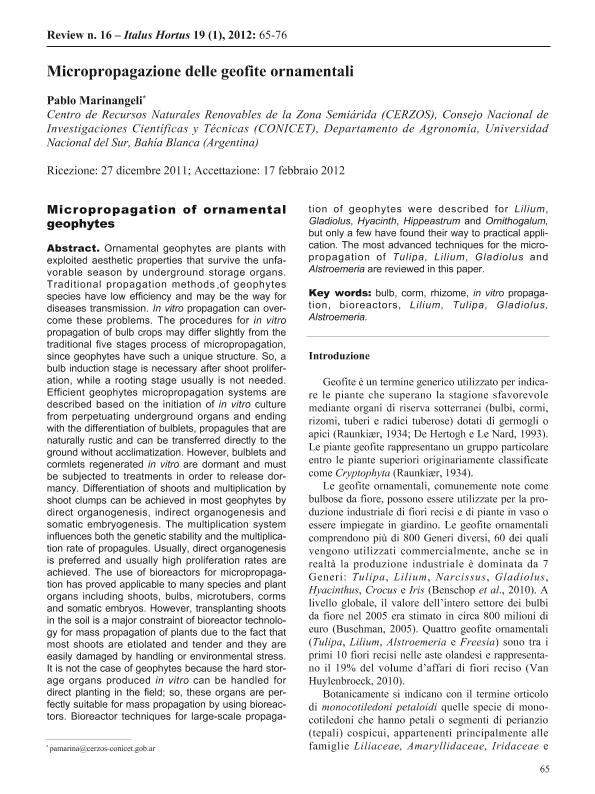Artículo
Le geofite ornamentali sono piante dotate di organi di riserva sotterranei che sopravvivono alla stagione sfavorevole e che vengono coltivate ed utilizzate per le loro caratteristiche estetiche. Di solito, i metodi tradizionali di propagazione delle specie geofite hanno una bassa efficienza e possono essere una via di trasmissione per alcune malattie. La propagazione in vitro può superare questi problemi. In questo lavoro vengono descritti sistemi di propagazione di specie geofite basati sull’impiego della coltura in vitro di organi sotterranei di sopravvivenza, che si realizza con la produzione di bulbetti ovvero propaguli naturalmente rustici che possono essere trasferiti direttamente in coltivazione a terra senza un periodo di acclimatazione. Particolare attenzione viene riservata ai sistemi di coltivazione che utilizzano bioreattori per la micropropagazione commerciale su larga scala. Ornamental geophytes are plants with exploited aesthetic properties that survive the unfavorable season by underground storage organs. Traditional propagation methods of geophytes species have low efficiency and may be the way for diseases transmission. In vitro propagation can overcome these problems. The procedures for in vitro propagation of bulb crops may differ slightly from the traditional five stages process of micropropagation, since geophytes have such a unique structure. So, a bulb induction stage is necessary after shoot proliferation, while a rooting stage usually is not needed. Efficient geophytes micropropagation systems are described based on the initiation of in vitro culture from perpetuating underground organs and ending with the differentiation of bulblets, propagules that are naturally rustic and can be transferred directly to the ground without acclimatization. However, bulblets and cormlets regenerated in vitro are dormant and must be subjected to treatments in order to release dormancy. Differentiation of shoots and multiplication by shoot clumps can be achieved in most geophytes by direct organogenesis, indirect organogenesis and somatic embryogenesis. The multiplication system influences both the genetic stability and the multiplication rate of propagules. Usually, direct organogenesis is preferred and usually high proliferation rates are achieved. The use of bioreactors for micropropagation has proved applicable to many species and plant organs including shoots, bulbs, microtubers, corms and somatic embryos. However, transplanting shoots in the soil is a major constraint of bioreactor technology for mass propagation of plants due to the fact that most shoots are etiolated and tender and they are easily damaged by handling or environmental stress. It is not the case of geophytes because the hard storage organs produced in vitro can be handled for direct planting in the field; so, these organs are perfectly suitable for mass propagation by using bioreactors. Bioreactor techniques for large-scale propagation of geophytes were described for Lilium, Gladiolus, Hyacinth, Hippeastrum and Ornithogalum, but only a few have found their way to practical application. The most advanced techniques for the micropropagation of Tulipa, Lilium, Gladiolus and Alstroemeria are reviewed in this paper.
Micropropagazione delle geofite ornamentali
Título:
Micropropagation of ornamental geophytes
Fecha de publicación:
04/2012
Editorial:
Società di Ortoflorofrutticoltura Italiana
Revista:
Italus Hortus
ISSN:
1127-3496
Idioma:
Italiano
Tipo de recurso:
Artículo publicado
Clasificación temática:
Resumen
Palabras clave:
Bulb
,
Corm
,
Rhizome
,
In Vitro Propagation
,
Lilium
,
Tulipa
,
Gladiolus
,
Alstroemería
Archivos asociados
Licencia
Identificadores
Colecciones
Articulos(CERZOS)
Articulos de CENTRO REC.NAT.RENOVABLES DE ZONA SEMIARIDA(I)
Articulos de CENTRO REC.NAT.RENOVABLES DE ZONA SEMIARIDA(I)
Citación
Marinangeli, Pablo Alejandro; Micropropagazione delle geofite ornamentali; Società di Ortoflorofrutticoltura Italiana; Italus Hortus; 19; 1; 4-2012; 65-76
Compartir




